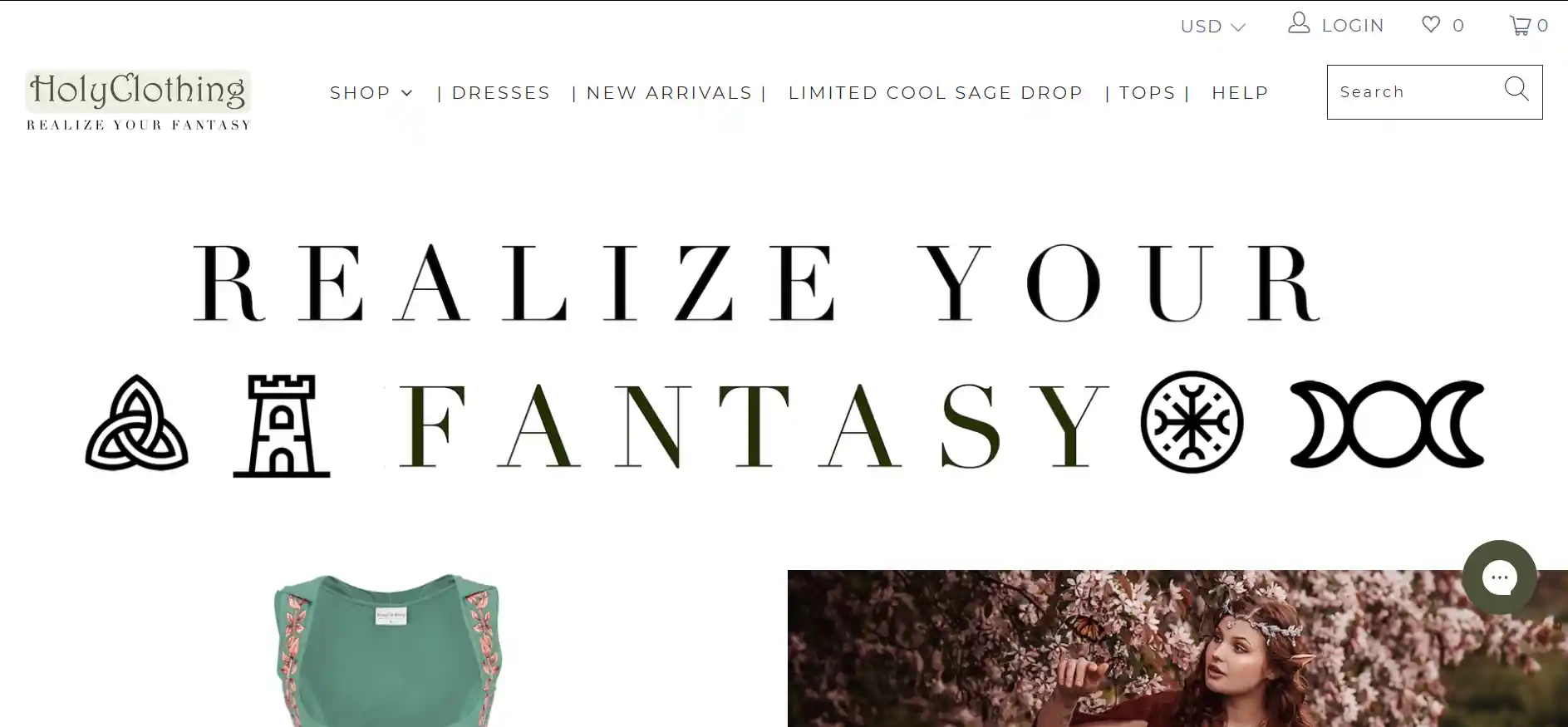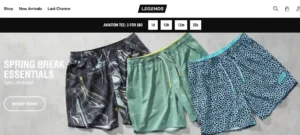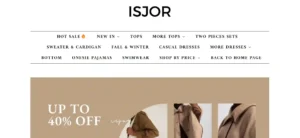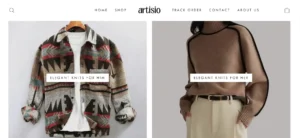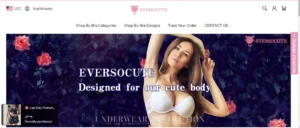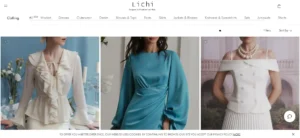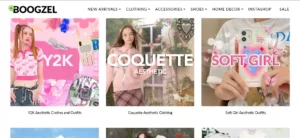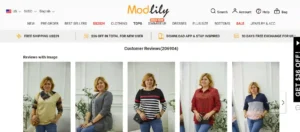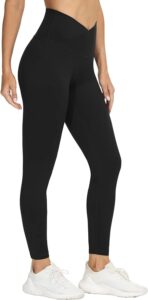Holy Clothing Review: Are you considering purchasing clothing from Holy Clothing but unsure if it’s a legitimate company or a scam?
In this comprehensive review, we will unveil the truth about Holy Clothing to help you make an informed decision before making a purchase.
What is Holy Clothing?
Holy Clothing has carved out a unique niche in the online fashion world, appealing to those with a penchant for the ethereal and the historical. This distinctive brand caters primarily to women, offering an array of garments that draw inspiration from bohemian aesthetics and the rich tapestries of Renaissance fashion.
Customers browsing through their online store will find themselves enchanted by an assortment of maxi dresses that seem to whisper tales of ancient forests and mystical realms, alongside tops and skirts that bear the intricate details and craftsmanship reminiscent of a bygone era. This is a place where fantasy meets fabric, where each piece is not just an article of clothing but a portal to an era of romance and adventure.
With its focus on creating visually striking and unique garments, Holy Clothing positions itself as more than just a clothing retailer—it becomes a curator of a very specific and enchanting lifestyle.
The brand’s commitment to offering such distinct designs underlines its appeal to those who seek to express themselves through their attire, making a statement that goes beyond the conventional and celebrates the individual’s connection to the historical and the fantastical.
Whether one is drawn to the brand for its aesthetic appeal or its nods to historical fashion, Holy Clothing presents a range of clothing options that promise to add a touch of magic to any wardrobe.
The Ethical Promise: Fact or Fiction?
Holy Clothing promotes itself as a brand deeply committed to ethical fashion, a claim that resonates with environmentally conscious consumers and those concerned about fair labor practices. This pledge to sustainability and ethical labor is a cornerstone of their identity, attracting a clientele that values these principles. The brand emphasizes its use of eco-friendly materials and assures that its products are made under fair working conditions. However, this stance on ethical practices has come under scrutiny from some quarters.
Critics and some consumers have questioned the transparency of Holy Clothing’s operations, pointing out a lack of detailed information regarding their supply chain, the specifics of their manufacturing process, and the true extent of their environmental impact. These inquiries into the brand’s ethical claims have led to a dialogue among shoppers about the authenticity of such commitments in the fashion industry at large.
While Holy Clothing continues to assert its dedication to ethical manufacturing, the calls for greater transparency have not gone unnoticed. Prospective buyers looking to support brands that align with their values on sustainability and labor rights might find themselves weighing the brand’s ethical promise against the need for more concrete evidence of its practices. This situation underscores a growing demand in the fashion industry for brands to not only adopt ethical principles but to also demonstrate them through clear, verifiable actions and data. As the conversation around ethical fashion evolves, Holy Clothing’s response to these calls for transparency could play a pivotal role in shaping its relationship with its customer base and its place in the wider fashion ecosystem.
A Closer Look at Product Quality
In evaluating the quality of Holy Clothing’s garments, customer feedback presents a spectrum of experiences. There are numerous accounts praising the brand for its exceptional craftsmanship, highlighting the durability and attention to detail in each piece. These positive reviews often commend the robustness of the fabrics used, as well as the precision in stitching, which collectively contribute to the longevity of the apparel. Enthusiastic customers have shared stories of their Holy Clothing items enduring regular wear and multiple washes without any compromise in quality, a testament to the brand’s commitment to producing resilient clothing.
Conversely, a segment of the customer base has voiced concerns over certain quality control issues. Complaints have surfaced regarding seams that unravel prematurely and fabrics that undergo unexpected shrinkage or fading after laundering, leading to disappointment and frustration for those affected. Such discrepancies in product quality suggest variability in the manufacturing process, which might not be entirely consistent across the brand’s range.
It is essential for potential buyers to navigate through these mixed reviews with a discerning eye. Paying close attention to the specific details mentioned in customer testimonials can offer valuable insights into the quality one might expect. Moreover, factoring in the type of material and care instructions provided by Holy Clothing could help mitigate any potential issues, ensuring that the garments maintain their allure and integrity over time. Engaging with these diverse perspectives on product quality allows for a more nuanced understanding of what Holy Clothing has to offer, guiding consumers in their decision-making process.
Sizing and Fit: Inclusivity at its Best?
One of the commendable features of Holy Clothing is its inclusive approach to sizing, offering a diverse range that aims to cater to various body shapes and sizes. This gesture towards inclusivity is a significant highlight for the brand, suggesting an awareness and appreciation for the diversity of their customer base. The intent to accommodate a broad spectrum of body types underscores the brand’s commitment to ensuring that more individuals can enjoy their unique and enchanting designs.
Despite this inclusive sizing initiative, customers have encountered some challenges regarding the accuracy of the fit. Reports from the community indicate that discrepancies in sizing can lead to confusion, with some garments fitting unexpectedly snug or loose. This inconsistency suggests a potential area for improvement in how Holy Clothing communicates sizing to its clientele. The brand’s size chart serves as a crucial tool for shoppers navigating these waters, yet the accuracy of this guide is paramount to a satisfying purchase. Additionally, the proactive approach of contacting customer service for sizing advice has proven beneficial for some, providing a more tailored shopping experience.
To navigate these sizing concerns, shoppers are encouraged to engage with the available resources thoughtfully. Examining customer reviews can also offer insights into how specific items fit, as fellow shoppers often share their own experiences with sizing accuracy. This collective pool of information can be invaluable in making informed decisions, helping to bridge the gap between the anticipation of a new garment and the reality of its fit upon arrival.
Customer Service: Responsive or Non-Existent?
Navigating customer service experiences with Holy Clothing yields a spectrum of accounts from shoppers, underscoring the variability in the company’s response to customer inquiries and concerns. There are tales of commendable service, where representatives have gone above and beyond to ensure customer satisfaction, swiftly addressing queries and resolving issues related to orders, shipping, or product specifics. These positive interactions highlight a potential for excellent customer care, suggesting that Holy Clothing possesses the capability to foster a supportive and engaging relationship with its clientele.
On the flip side, a contrasting narrative emerges from a segment of the customer base. These individuals recount experiences characterized by delayed responses, or in some cases, a complete lack of communication from the customer service team. This inconsistency not only sows seeds of frustration among customers but also raises questions about the reliability of the support system in place. For shoppers contemplating a purchase, these mixed signals can introduce an element of uncertainty regarding the level of service they can expect, especially should they encounter any issues with their orders.
For those considering making a purchase, it may be prudent to proactively engage with Holy Clothing’s customer service to assess their responsiveness firsthand. Initiating contact might provide a glimpse into the level of attentiveness and support the brand is willing to offer, setting the stage for a more informed decision about whether to proceed with a transaction. This approach allows potential buyers to gauge the responsiveness of the customer service team, equipping them with a more concrete understanding of what to anticipate in terms of customer care.
The Price Point: Worth the Investment?
Navigating the price landscape of Holy Clothing reveals a collection of garments that span a wide range of price tags. For some shoppers, the allure of these unique, ethereal designs and the promise of ethical manufacturing practices justify the investment. The brand’s dedication to creating pieces that resonate with a sense of historical and mystical charm can, for many, be worth the extra expense, especially when considering the effort to ensure fair labor practices and the use of eco-friendly materials.
On the other side of the spectrum, there are consumers who scrutinize the cost-to-quality ratio more closely. Among these voices, concerns arise regarding whether the prices accurately reflect the craftsmanship and longevity of the garments, especially in light of the mixed feedback regarding product quality and consistency. For individuals prioritizing budgetary constraints or those with specific expectations of durability and craftsmanship, the decision becomes more complex.
Engaging with Holy Clothing’s offerings necessitates a careful consideration of how much value one places on the brand’s unique aesthetic, ethical pledges, and the overall shopping experience it provides. The brand caters to a niche market, and for those who find a deep connection with the style and ethical stance of Holy Clothing, the prices may represent a worthwhile expenditure. However, potential buyers are encouraged to weigh these factors carefully against their personal criteria for value, ensuring that their investment aligns with both their wardrobe desires and their ethical considerations.
Unpacking Customer Reviews: Praise and Criticisms
Exploring the world of customer reviews for Holy Clothing reveals a complex tapestry of individual experiences, each colored by expectations and outcomes. On one hand, a significant portion of feedback glows with positive sentiments, where customers celebrate the brand’s unique aesthetic and its reflection of their personal style. These reviews often highlight the distinctive designs and the joy of wearing something that stands out from mainstream fashion. Shoppers speak of receiving compliments, feeling a deep connection with the historical and mystical elements embedded in each garment, and the satisfaction of wearing clothes that truly represent their identity.
Conversely, the landscape of customer feedback is not without its valleys. Criticisms emerge, particularly focusing on instances where expectations were not met in terms of quality or the handling of customer service issues. Some reviews point out discrepancies between the perceived value of the products and their actual performance, noting experiences with wear and tear that contradicted the brand’s promises of durability. Issues with sizing inaccuracies also surface, reflecting challenges in achieving the perfect fit despite the brand’s inclusive sizing efforts. These critical reviews often express a sense of letdown, particularly when the reality of the product or service fell short of the anticipation built around the brand’s image.
This dichotomy in customer experiences underscores the subjective nature of shopping with Holy Clothing. Each review offers a piece of the larger puzzle, providing insights that range from sheer delight to disappointment. For potential customers, sifting through these narratives offers a window into the diverse outcomes of shopping with Holy Clothing, painting a picture that requires careful consideration.
The Final Verdict: Legit or Scam?
In assessing the intricacies of Holy Clothing, it becomes evident that the brand offers a genuine and unique experience to its clientele. Through detailed exploration of its product quality, ethical promises, sizing inclusivity, customer service responsiveness, and pricing strategy, Holy Clothing demonstrates attributes that align with a legitimate business model. The array of customer experiences, both praising and critical, signifies a brand that is very much real and engaged in the market, albeit not without its areas for improvement. Despite some customers facing challenges with product consistency or service experiences, the overarching narrative supports the legitimacy of Holy Clothing as a company committed to providing distinctive and ethically minded fashion options. It’s imperative for potential buyers to consider these dimensions thoughtfully, recognizing that individual experiences may vary. This careful consideration will guide one in deciding if Holy Clothing aligns with their expectations and values, far from being a scam but rather a brand with a unique offering in the fashion industry.

